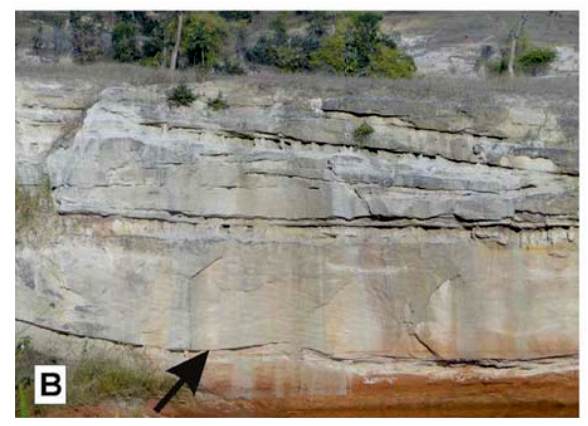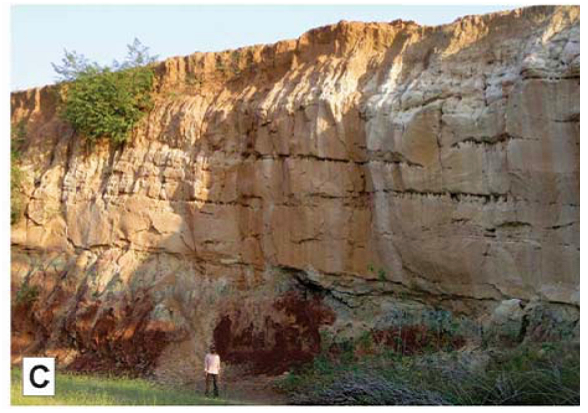Tiki Fm
Type Locality and Naming
South Rewa Basin: Many workers had lumped Pali and Tiki formations together. According to Hughes (1881) and Aggarwal et al. (1993) they are two distinct lithological units. Fox (1931) named the sedimentary beds occurring in low-lying tracts between Somarkoini and Tiki as “Tiki Beds”. Tiki and Pali beds were placed together in Pali Formation (Sastry et al., 1977). Kundu et al. (1993) held the opinion that these two lithounits should be separated from each other because of their lithological and faunal distinctiveness. Johilla river section between Beohari hills (near Tiki) to Neosi is designated as the type section. [Original Publications: Hughes, T.W.H., 1881. Notes on the South Rewa Gondwana Basin. Records of Geological Survey of lndia 14, 126 -138; Fox, C.S. 1931. Gondwana System and related formations. Memoirs of Geological Survey of India 8, 1-241; Sastry, M.V.A., Acharyya, S.K., Shah, S.C., Satsangi, P.P., Ghosh, S.C., Raha, P.K., Singh, G., Ghosh, R.N. 1977. Stratigraphic lexicon of Gondwana formations of India. Geol. Surv. India, Misc. Publ. 36: 1-170; Agarwal, R.P., Dotiwala, S.F., Bhoj, R., 1993. Structural framework of Son-Mahanadi Gondwana basin based on the study of remote sensing data: Gondwana Geol. Magazine, Spec. Vol. Birbal Sahni Centre, National Symposium Gondwana, India, 207– 217; Kundu, A., Pillai, A., Thanavelu, C. 1993. Elucidation of the stratigraphic interrelationship of Pali, Tiki and Parsora formations of South Rewa Basin. Gondwana Geological Magazine Special Publication, Birbal Sahni Centenary National Symposium on Gondwana of India, Nagpur, 49-55.]
[Figure 1: A) Map major Gondwana basins of the peninsular India; B) Locatioon of Tiki within the Rewa basin (after Mukherjee et al., 2012); (C) Geological Map of the study area, Tiki area in parts of Shahdol district of Madhya Pradesh, India (after Datta and Das, 2001; Datta et al., 2004; Mukherjee, et al., 2012); D). Composite litholog of Tiki area, south Rewa Gondwana basin, Sahdol, M.P. India, (after Datta and Das, 2001; Datta et al., 2004; Kumar & Sharma, 2019)]
Lithology and Thickness
Claystone. The Tiki Formation is primarily a mud-dominated unit with subordinate amount of coarse to fine-grained quartz-feldspathic sandstone units. Mudstone units vary in color from dark reddish-brown to moderate red to very dark red (field photograph A). The Tiki mudstones show well-developed paleosol horizons and pedogenic features (Mukherjee et al., 2012). Besides mudstones, carbonate grainstone conglomerates in the form of caliche-derived calcirudite/calcarenite units is the second constituent of the Tiki Formation. Most of these multistoried units with large trough-cross-bedding occur within the red mudstone beds. The sandstones of the Tiki Formation are coarse grained, pinkish-gray to pale orange in color and at places pebbly or medium grained and grade into mudstone units at the top (field photographs B and C). The thickness of the formation is about 400 m (Mukherjee et al., 2012).
[Figure 2 A,B,C: Field photographs of red mudstones (A), multistoried channel sandstone (B), and thick sandstone unit overlying red mudstones (C) of the Tiki Formation near Tiki village (after Mukherrjee et al., 2012)]
Relationships and Distribution
Lower contact
Mukherjee et al. (2012) opined that the Tiki Formation has a sharp contact with the underlying Karki Fm.
Upper contact
The Tiki Formation has an unconformble contact with the overlying Parsora Fm.
Regional extent
South Rewa Basin: Johilla river between Beohari Hills, Neosi, Hartala Hills, Janar river, Harai, Son river sections, Giar, Tharipathar.
GeoJSON
Fossils
Vertebrate taxa recovered from the Tiki Formation comprises Fish: Ptychoceratodus (Ceratodus) sp. (Sastry et al., 1977; Martin, 1982), Ptychoceratodus oldhami, Gnathorhiza sp., (Bhat and Ray, 2018), Lonchidion estesi, Lonchidion incumbens (Prasad et al., 2008), Parvodus (Pristrisodus) tikiensis, Lissodus (Pristrisodus) duffini (Prasad et al., 2008; Bhat et al., 2018a), Mooreodontus (Xenacanthus) indicus (Jain, 1980; Hampe and Schneider, 2010; Bhat et al., 2018b), Mooreodontus jaini, Tikiodontus asymmetricus, Elasmobranchii incertae sedis (Bhat et al., 2018b); Amphibian: Panthasaurus (Metoposaurus) maleriensis (Sengupta, 1992, 2002; Hunt, 1993; Chakravorti and Sengupta, 2018); Reptiles: Hyperodapedon tikiensis (Mukherjee and Ray, 2014), Parasuchus hislopi (Chatterjee, 1978), Tikisuchus romeri (Chaterjee and Majumdar, 1987), Tikiguania estesi (Datta and Ray, 2006), Rewaconodon tikiensis (Datta et al., 2004), Ruberodon roychowdhurii (Ray, 2015), Theropoda indet., Dinosauria indet. (Rakshit et al., 2018); Mammals: Gondwanadon tapani (Datta and Das, 1996), Tikitherium copei (Datta, 2005). Megaflora: Lepidopteris madagascarensis, L. stormbergensis, Dicroidium hughesii, D. zuberi, D. giarensis, D. coriaceum, Elatocladus denticulatus, E. raoi, Sphenobaiera janarensis, Pagiophyllum bosei, Yabiella indica, Desmiophyllum singhii, Xylopteris sp. Baiera sp. (Pal, 1984); Podocarpoxylon tikiense (Awatar and Rajanikanth, 2007). Plant assemblage comprises microspores: Staurosaccites. Samaropollenites, Aulisporites. Todisporites, Carnisporites, Rimaesporites, Falcisporites, Dictyophyllidites, Infernopollenites, Tikisporites, Camaerozonosporites, Brachysaccus and Chordasporites (Maheshwari and Kumaran, 1979; Kumaran and Maheshwari, 1980); megaspores: Bokarosporites, Banksisporites, Biharisporite, Verrutriletes, Bacutriletes, Horstisporites, Erlansonisporites, Hughesisporites, Nathorstisporites, Minerisporites and Aneuletes (Banerji et al., 1978; Pal, 1991, 1996)
Age
Depositional setting
The Tiki Formation was deposited in a fluvial regime. Laterally connected channel-fill sand bodies and presence of thick mudstone units suggest channel and overbank facies where the river channel was confined within the extensive floodplain deposits of the Tiki Formation (Mukherjee et al., 2012). The exposed areas of the Tiki floodplain were subjected to soil forming processes resulting in the formation of caliche profiles (Mukherjee et al., 2012). The red coloration of the floodplain fines and the calcareous paleosol profiles indicate a semi-arid climate with seasonal rainfall during the deposition of Tiki sediments (Retallack et al., 1996).
Additional Information
References
Aggarwal, R.P., Dotiwala, S.F., Bhoj, R., 1993. Structural framework of Son-Mahanadi Gondwana basin based on the study of remote sensing data: Gondwana Geol. Magazine, Spec. Vol. Birbal Sahni Centre, National Symposium Gondwana, India, 207– 217. Awatar, R., Rajanikanth, A., 2007.Triassic Conifer wood from the Tiki Formation, South Rewa Basin, Madhya Pradesh, India. The Palaeobotanist 56, 127-132. Banerji J, Kumaran K & Maheshwari HK 1978. Upper Triassic sporae-dispersae from the Tiki Formation: Megaspores from the Janar Nala Section, South Rewa Gondwana Basin. Palaeobotanist 25: 1-26. Bhat MS and Ray, S. 2018. A record of new lungfishes (Osteichthyes: Dipnoi) from the Carnian (Upper Triassic) of India.Historical Biology, https://doi.org/10.1080/08912963.2018.1499020 Bhat MS, Ray S, Datta PM. 2018a. A new hybodont shark (Chondrichthyes, Elasmobranchii) from the Upper Triassic Tiki Formation of India with remarks on its dental histology and biostratigraphy. J Paleontol. 92: 221–239. Bhat MS, Ray S, Datta PM. (2018b). A new assemblage of freshwater sharks Chondrichthyes: elasmobranchii) from the Upper Triassic of India. Geobios doi.org.10.1016/j.geobios.2018.06.004. Chakravorti, S.; Sengupta, D.P. (2018). Taxonomy, morphometry and morphospace of cranial bones of Panthasaurus gen. nov. maleriensis from the Late Triassic of India. Journal of Iberian Geology. doi:10.1007/s41513-018-0083-1 Chatterjee, S. 1978a. A primitive parasuchid (phytosaur) reptile from the Upper Triassic Maleri Formation of India: Palaeontology, 21, 83-127. Chatterjee, S. and Majumdar, P. K. 1987.Tikisuchus romeri, a new rauisuchid reptile from the Late Triassic of India: Journal of Paleontology, 61: 787-793. Datta, P. M. 2005. Earliest mammal with transversely expanded upper molar from the Late Triassic (Carnian) Tiki Formation, South Rewa Gondwana Basin, India: Journal of Vertebrate Paleontology, 25: 200-207. Datta, P. M., and Das, D. P. 1996. Discovery of the oldest mammal from India: Indian Minerals, 50: 217-222 Datta, P. M., Das, D. P., and Luo, Z. X. 2004. A Late Triassic dromatheriid (Synapsida: Cynodontia) from India: Annals of Carnegie Museum, 73: 72-84. Datta, P. M. and Ray, S. 2006. Earliest lizard from the Late Triassic (Carnian) of India: Journal of Vertebrate Paleontology, 25: 200-207 Dutta, P.K., Ghosh, S.K. (1993) The century old problem of Pali- Parsora-Tiki stratigraphy and its bearing on the Gondwana classification of peninsular India. Jour. Geol. Soc. India, 42, 17-31. Fox, C.S. 1931. Gondwana System and related formations. Memoirs of Geological Survey of India 8, 1-241. Hampe, O., Schneider, J., 2010. Mooreodontus name, in Chondrichthyes, Paleozoic Elasmobranchii: Teeth, in: Schultze, H.-P., (Ed.), Handbook of Paleoichthyology, 3D. Verlag Dr. Friedrich Pfeil, München. Hughes, T.W.H., 1881. Notes on the South Rewa Gondwana Basin. Records of Geological Survey of lndia 14, 126 -138. Hunt, A.P., 1993. Revision of the Metoposauridae (Amphibia: Temnospobdyli) and description of a new genus from Western North America. In: Morales, M., (Ed.), Aspects of Mesozoic Geology and paleontology of the Colorado Plateau, Museum of Northern Arizona Bulletin, 59: 67–97. Jain, S.L., 1980. Freshwater xenacanthid (=Pleuracanth) shark fossils from the Upper Triassic Maleri Formation, India. Journal of Geological Society of India 21, 39–47. Kumaran, K.P.N. and Maheshwari, H.K. 1980. Upper Triassic Sporae dispersae from the Tiki Formation 2: Miospores from the Janar Nala Section, South Rewa Gondwana Basin, India. Palaeontographica B171: 137-164. Kundu, A., Pillai, A., Thanavelu, C. 1993. Elucidation of the stratigraphic interrelationship of Pali, Tiki and Parsora formations of South Rewa Basin. Gondwana Geological Magazine Special Publication, Birbal Sahni Centenary National Symposium on Gondwana of India, Nagpur, 49-55. Lele, K.M., 1964. The problem of Middle Gondwana of India. Proceedings of the 22tld International Geological Congress, New Delhi, Session IX Gondwana, New Delhi: 181-202. Maheshwari, H.K., Kumaran, K.P.N., 1979. Upper Triassic Sporae dispersae from the Tiki Formation I: Miospores from the Tharipathar and Giar Section, South Rewa Gondwana Basin, India. Palaeontographica B173: 26-84. Martin M. 1982. Nouvelles données sur la phylogénie et la systématique des Dipneustes postpaléozoiques, conséquences stratigraphiques et paléogeographiques. Geobios Mémoire spécial. 6: 53–64. Mukherjee, D., Ray, S., Chandra, S., Pal, S., Bandyopadhyay, S., 2012. Upper Gondwana Succession of the Rewa Basin, India: Understanding the Interrelationship of Lithologic and Stratigraphic Variables. Journal Geological Society of India, 79, 563-575 Mukherjee, D. and Ray, S. 2014. A new Hyperodapedon (Archosauromorpha: Rhynchosauria) from the Upper Triassic of India: implications for rhynchosaur Phylogeny. Palaeontology, 57: 1241-1276. Pal, P.K., 1984, Triassic plant megafossils from the Tiki Formation, South Rewa Gondwana Basin, India. The Palaeobotanist 32. 253-309. Pal P.K. 1991. Megaspores from the Upper Triassic beds of Giar, Tiki Formation, India. Global Environment and Diversification of plants through Geological Time. Professor Birbal Sahni Centenary International Conference, Allahabad (Abstract). Pal P.K. 1996. Stratigraphy of Post Barakar Sequence in Johilla Son Valley, South Rewa Basin, India. In: PK Pal (Editor) Contemporary thoughts in Plant Sciences, pp. 103-108, Academic Staff College, Burdwan University. Prasad, G.V.R., Singh, K., Parmar, V., Goswami, A., Sudan, C.S., 2008. Hybodont shark teeth from continental Upper Triassic deposits of India. In: Arratia, G., Schultze, H.-P., Wilson, M.V.H., (Eds.), Mesozoic Fishes 4: Homology and Phylogeny. Verlag Dr. Friedrich Pfeil, Germany, pp. 413–432. Retallack, G.J., Veevers, V.J. And Morante, R. (1996) Global coal gap between Permian-Triassic extinction and Middle Triassic recovery of peat forming plants. GSA Bull., 108, 195-207. Rakshit, N., Bhat, M. S., Ray, S. and Datta, P. M. 2018. First report of dinosaurian claws from the Late Triassic of India. Palaeoworld, 27, 179–187 Ray, 2015 Sastry, M.V.A., Acharyya, S.K., Shah, S.C., Satsangi, P.P., Ghosh, S.C., Raha, P.K., Singh, G., Ghosh, R.N., 1977. Stratigraphic lexicon of Gondwana formations of India. Geol. Surv. India, Misc. Publ. 36, 1-170. Sengupta, D. P. (1992). Metoposaurus maleriensis Roychowdhury from the Tiki Formation of Son-Mahanadi Valley of Central India. Indian Journal of Geology, 64, 300–305. Sengupta, D.P., 2002. Indian Metoposaurid Amphibians revised. Palaeontological Research 6 (1): 41–65. Shah, B.A. (2000) Revision of age of Parsora Formation from plant assemblages in Karkati area, Johilla-Son valley, Rewa basin, M. P. Indian Minerals, 54, pp.223-232. Shah, B.A. (2001) Fluvial sedimentation of Tiki-Hartala formations (Triassic-Jurassic) in a part of Johilla-Son Valley, Rewa basin, MP. Indian Jour. Geol., 72, 93-106. Shah, B.A. (2004) Gondwana lithostratigraphy of peninsular India. Gondwana Res., 7, 600-607.



